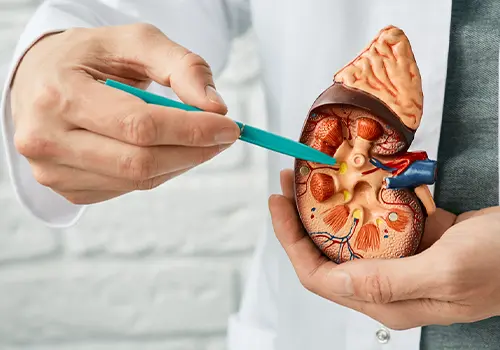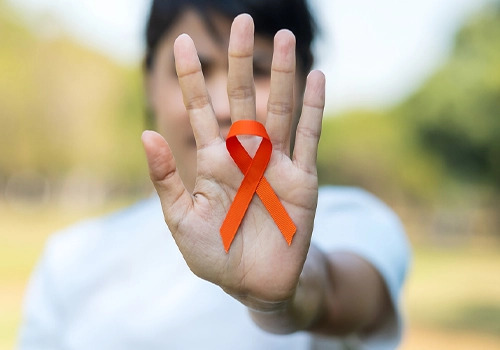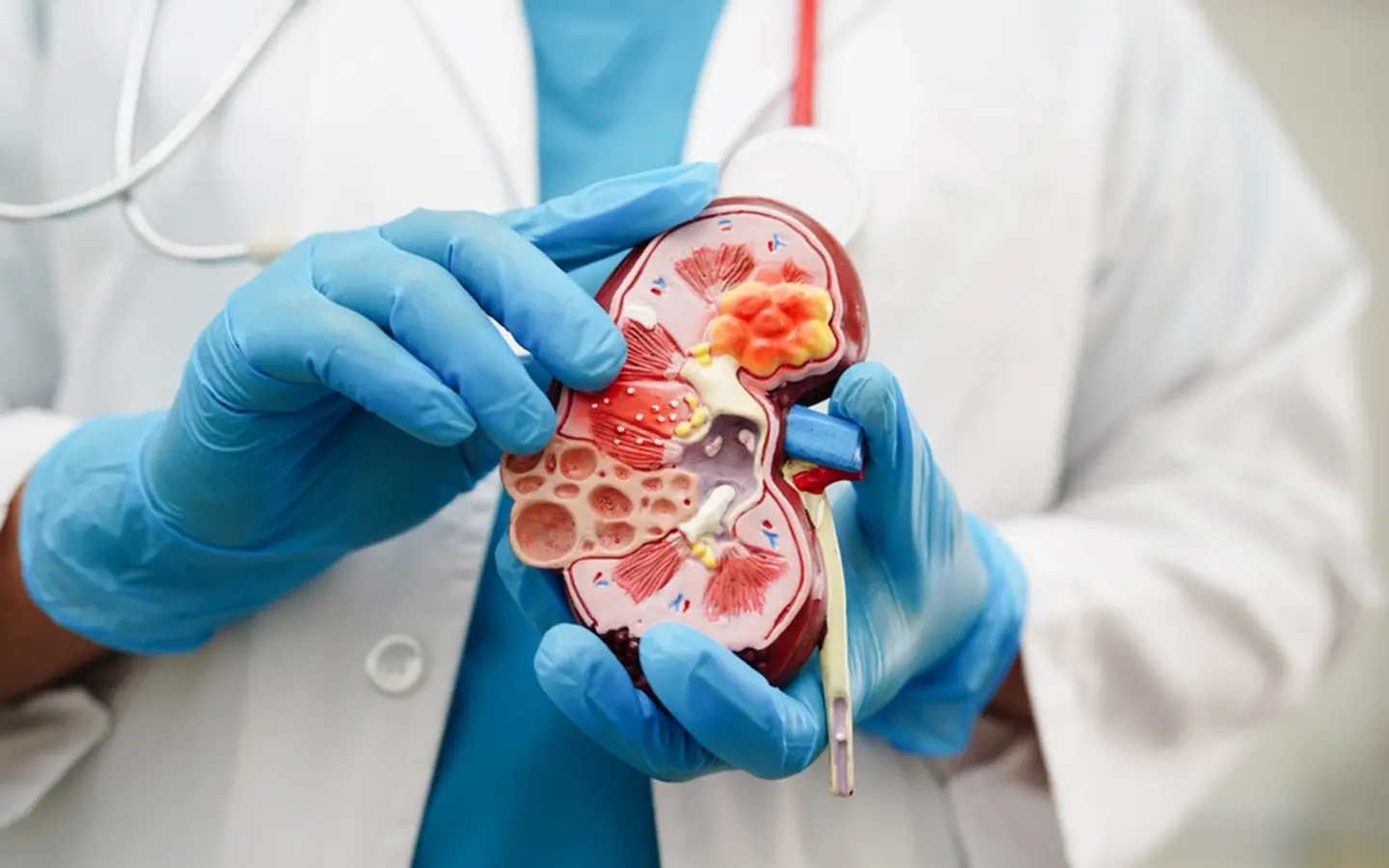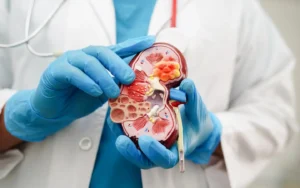Kidney Cancer: What Is It?
Kidney cancer is a type of disease in which the growth of kidney cells becomes uncontrolled, ultimately leading to the formation of tumors. It’s worth noting that in these conditions, tumor growth occurs rapidly and must be addressed promptly.
Each person has two bean-shaped kidneys in their body, each about the size of an adult’s fist, protected by the left and right rib cages. In men, each kidney weighs around 125 to 175 grams, while in women, it’s approximately 115 to 155 grams.
The length of the kidneys is about 11 to 14 centimeters, their width is 6 centimeters, and their thickness is 4 centimeters. They are directly encased and protected by a fibrous capsule made up of dense and irregular connective tissue, helping to maintain their shape and protect them.
Despite their small size, kidneys perform complex and vital functions that help regulate the entire body. Their main task is blood filtration. Essentially, blood enters the kidneys, where excess substances are separated, and if necessary, adjustments to salt, water, and minerals are made. The purified blood returns to the body, while urine is collected in the kidney’s renal pelvis, a cup-shaped structure, and is expelled to the bladder through a tube called the ureter. Additionally, kidneys play a significant role in regulating blood pressure.
Staging Kidney Cancer in Terms of Disease Progression
The higher the grades of kidney cancer, the more advanced the disease progression, and the greater the risk. Lower-grade cancers tend to grow more slowly, and their likelihood of spreading is lower compared to higher-grade cancers.
Grade 1 Kidney Cancer
– A tumor that is 7 centimeters or smaller and confined to one kidney.
Grade 2 Kidney Cancer
– A tumor that is larger than 7 centimeters and confined to one kidney.
Grade 3 Kidney Cancer
– A tumor that is near a lymph node in the kidney.
– A tumor that involves blood vessels within the kidney and may also involve nearby lymph nodes.
– A tumor located in the fatty tissue around the kidney, which may also involve nearby lymph nodes.
– A tumor that has extended into major veins or the surrounding tissue but not bilaterally into the supra-kidney glands.
Grade 4 Kidney Cancer
– Cancer that has spread to tissues outside the fatty layer around the kidney and may involve nearby lymph nodes or may have spread to other organs such as the intestines, pancreas, or lungs.

Types of Kidney Cancer
Kidney cancer comes in various types, including:
- Renal Cell Carcinoma (RCC), which is the most common type of kidney cancer.
- Transitional Cell Carcinoma, which is more similar to bladder cancer and is often treated like bladder cancer.
- Wilms Tumor, which is the most common kidney cancer type among children. It differs from adult kidney cancer and requires different treatment.
- Kidney Sarcoma, a rare tumor that originates from the kidney’s connective tissue.
Prevention of Kidney Cancer
Several factors can increase the risk of kidney cancer, including smoking, excessive use of certain pain medications for an extended period, obesity, high blood pressure, a family history of kidney cancer, and inadequate water intake.
Symptoms of Kidney Cancer
Some of the key symptoms indicating kidney cancer include:
- Persistent pain in the lower back and side.
- Presence of blood in the urine.
- Fever and fatigue.
- Unexplained weight loss.
- Feeling a mass or lump in the abdomen.
Diagnostic Methods for Kidney Cancer
To diagnose kidney cancer, a physician performs a thorough examination of the abdomen and flanks to check for any masses. They also inquire about the patient’s health habits, any past history of pain, and previous treatments. To confirm kidney cancer, the physician may conduct one or more of the following tests:
✔️ Urinalysis: This test checks for the presence of blood or other signs of cancer in your urine.
✔️ Blood tests: These provide insights into your kidney function.
✔️ Intravenous Pyelography or X-ray imaging: This involves injecting a contrast dye into the bloodstream, allowing the doctor to visualize any tumors in the kidney.
✔️ Sonography (Ultrasound): Using sound waves to create images of the individual’s kidneys. It can help determine whether a tumor is solid or fluid-filled.
✔️ Computed Tomography (CT) Scan: Utilizes X-rays and computer technology to produce detailed images of the patient’s kidneys. CT scans have largely replaced pyelography and ultrasound as a diagnostic tool for kidney cancer.

✔️ Magnetic Resonance Imaging (MRI): Employs strong magnetic fields and radio waves to create detailed images of soft tissues inside the body. Sometimes, a contrast agent may be injected to enhance the image quality.
✔️ Renal Angiography: Used to evaluate the blood supply to the tumor. While not commonly used, it can assist in detecting small tumors.
✔️ Biopsy: Tissue sampling, which may be employed by the doctor to confirm the diagnosis.
Treatment Options for Kidney Cancer
The choice of treatment for kidney cancer depends on the stage of cancer and the location of the tumor within the kidney, and it is determined by a physician. Most individuals diagnosed with kidney cancer will undergo some form of surgery. Here are the primary surgical treatments:
Simple Nephrectomy: In a simple nephrectomy, only the affected kidney is removed.
Partial Nephrectomy: In a partial nephrectomy, the cancerous portion of the kidney and a portion of the surrounding tissue are removed. This procedure is typically used for patients with small tumors (less than 4 centimeters) or when a radical nephrectomy could harm the other kidney.
Patients can live with one kidney as long as it maintains adequate function. If both kidneys are removed or if they no longer function adequately, the patient will require blood cleansing through a dialysis machine or a kidney transplant.
Radical Nephrectomy: A radical nephrectomy involves the removal of the entire kidney, the adrenal gland above the kidney, and the surrounding tissues. It often includes the removal of nearby lymph nodes as well. This is the most common type of surgery for kidney cancer and can now be performed through a small incision using laparoscopy.
Kidney Transplant: Kidney transplantation is an option when cancer is confined to the kidney, and a kidney donor is available.
If surgery cannot completely remove cancerous masses, the doctor may employ alternative methods to assist in tumor reduction.
Cryotherapy: Cryotherapy uses extreme cold to destroy the tumor.
Radiofrequency Ablation: Radiofrequency ablation employs high-energy radio waves to burn and destroy the tumor.
Arterial Embolization: Arterial embolization involves injecting a substance into the artery leading to the kidney, blocking the blood flow to the tumor. This procedure may be used to shrink the tumor before surgery.

Chemotherapy: Indeed, Chemotherapy is used sparingly in the treatment of kidney cancer and is only employed in specific cases. In some instances, it may be used after surgery to prevent the cancer from returning.
Targeted Therapy: In targeted therapy, substances or drugs are employed that can identify cancer cells and attack them without harming normal cells. In the case of kidney cancer treatment, specific drugs are used to inhibit the formation of blood vessels. Essentially, these substances impede the growth of blood vessels within the cancerous mass and its vicinity. Consequently, with an insufficient blood supply, the cancerous mass gradually shrinks and ultimately disappears.
Last Word
Remember, prevention is better than cure. Factors like smoking, obesity, high blood pressure, and inadequate water intake can increase your risk. Make lifestyle changes today to reduce your risk.
Kidney cancer is a serious disease that requires immediate attention. It can rapidly progress from a small tumor confined to one kidney to a life-threatening condition that spreads to other organs.
Don’t wait for symptoms to worsen. Schedule a consultation with Dr. Maadico today. Your health is in your hands. Take the first step towards a healthier future now!
Get a Free Consultation
Frequently Asked Questions
- How much does kidney cancer treatment cost?
The cost of kidney cancer treatment varies depending on factors such as
- surgical equipment used during the procedure
- the number of surgical services in the operating room
- the duration of hospitalization
- required medical tests as determined by the physician, medications, and para-clinical services such as imaging.
It is not possible to accurately determine the treatment costs for kidney cancer before visiting the hospital, as they differ from person to person based on the diagnosis and surgeon’s recommendations.
- What are the ways to prevent kidney cancer?
Various factors contribute to the development of different types of cancer, including kidney cancer. Researchers are studying the factors leading to this type of cancer, including prevention methods. Although there is no proven method to completely prevent this disease, the following approaches can help reduce the risk of kidney cancer:
-
- Avoiding smoking and tobacco products
- Maintaining a healthy weight
- Drinking an adequate amount of water and other fluids
- Following a low-fat diet rich in fruits and vegetables
- Preventing and treating high blood pressure

- Is kidney cancer an inherited disease?
While genetics can play a role in most diseases, environmental factors and individuals’ lifestyles are the primary contributors to the development of kidney cancer.
- What is the role of nutrition in kidney cancer development?
So far, no specific food that causes kidney cancer has been identified. However, some chemicals, pesticides, toxins, and even contaminants that unintentionally enter the food chain can be potent carcinogens.
- What are the post-operative care procedures for kidney cancer?
- Avoid smoking before and after the surgery. Smoking slows down the wound-healing process and increases the risk of respiratory complications during the procedure. If you are a smoker, it’s advisable to quit at least two weeks before the surgery.
- If you require pain relief or analgesics in the week leading up to the surgery, follow your doctor’s recommendations to prevent excessive bleeding during the procedure.
- Immediate replacement of fluids and blood lost during nephrectomy surgery due to the rich blood supply to the kidney, bleeding, and shock are significant post-surgical concerns.
- Use prescribed antibiotics after surgery and assess their effects on the kidneys.
- Use prescribed pain relievers and keep the surgical site stable during coughing to control pain.
- Encourage the patient to change positions perform incentive spirometry, and encourage early ambulation from the bed.
- How long is the hospital stay after kidney cancer surgery?
Several factors influence the duration of a patient’s hospital stay. Some of these factors include the patient’s overall health, age, the type of surgery, and the severity of the disease. On average, the hospital stay ranges from 5 to 7 days.


